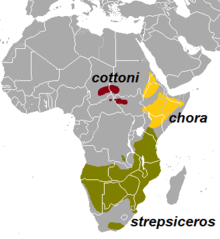Greater kudu
| Greater kudu | |
|---|---|
 |
|
| Male at Kruger National Park in South Africa | |
 |
|
| Female at Chudop waterhole, Etosha, Namibia | |
| Scientific classification | |
| Kingdom: | Animalia |
| Phylum: | Chordata |
| Class: | Mammalia |
| Order: | Artiodactyla |
| Family: | Bovidae |
| Subfamily: | Bovinae |
| Genus: | Tragelaphus |
| Species: | T. strepsiceros |
| Binomial name | |
|
Tragelaphus strepsiceros (Pallas, 1766) |
|
 |
|
| Ranges of the subspecies | |
| Synonyms | |
|
Strepsiceros chora |
|
Strepsiceros chora
Strepsiceros cottoni
Strepsiceros strepsiceros
Strepsiceros zambesiensis
The greater kudu (Tragelaphus strepsiceros) is a woodland antelope found throughout eastern and southern Africa. Despite occupying such widespread territory, they are sparsely populated in most areas, due to a declining habitat, deforestation and poaching. The greater kudu is one of two species commonly known as kudu, the other being the lesser kudu, T. imberbis.
Kudu, or koodoo, is the Khoikhoi name for this antelope. Tragos (Greek) denotes a he-goat and elaphos (Greek) a deer. Strepho (Greek) means "twist", and strephis is "twisting". Keras (Greek) refers to the horn of the animal.
Greater kudus have a narrow body with long legs, and their coats can range from brown/bluish grey to reddish brown. They possess between 4 and 12 vertical white stripes along their torso. The head tends to be darker in colour than the rest of the body, and exhibits a small white chevron which runs between the eyes.
Greater kudu bulls tend to be much larger than the cows, and vocalize much more, utilizing low grunts, clucks, humming, and gasping. The bulls also have large running along their throats, and large horns with two and a half twists, which, were they to be straightened, would reach an average length of 120 cm (47 in), with the record being 187.64 cm (73.87 in). They diverge slightly as they slant back from the head. The horns do not begin to grow until the bull is between the age of 6–12 months, twisting once at around 2 years of age, and not reaching the full two and a half twists until they are 6 years old; occasionally they may even have 3 full turns.
...
Wikipedia

